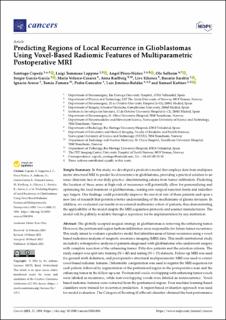| dc.contributor.author | Cepeda, Santiago | |
| dc.contributor.author | Luppino, Luigi Tommaso | |
| dc.contributor.author | Pérez-Núñez, Angel | |
| dc.contributor.author | Solheim, Ole Skeidsvoll | |
| dc.contributor.author | García-García, Sergio | |
| dc.contributor.author | Velasco-Casares, María | |
| dc.contributor.author | Karlberg, Anna Maria | |
| dc.contributor.author | Eikenes, Live | |
| dc.contributor.author | Sarabia, Rosario | |
| dc.contributor.author | Arrese, Ignacio | |
| dc.contributor.author | Zamora, Tomás | |
| dc.contributor.author | Gonzalez, Pedro | |
| dc.contributor.author | Jiménez-Roldán, Luis | |
| dc.contributor.author | Kuttner, Samuel | |
| dc.date.accessioned | 2023-07-18T13:53:22Z | |
| dc.date.available | 2023-07-18T13:53:22Z | |
| dc.date.created | 2023-04-20T08:53:38Z | |
| dc.date.issued | 2023 | |
| dc.identifier.citation | Cancers. 2023, 15 (6), . | en_US |
| dc.identifier.issn | 2072-6694 | |
| dc.identifier.uri | https://hdl.handle.net/11250/3079719 | |
| dc.description.abstract | The globally accepted surgical strategy in glioblastomas is removing the enhancing tumor. However, the peritumoral region harbors infiltration areas responsible for future tumor recurrence. This study aimed to evaluate a predictive model that identifies areas of future recurrence using a voxel-based radiomics analysis of magnetic resonance imaging (MRI) data. This multi-institutional study included a retrospective analysis of patients diagnosed with glioblastoma who underwent surgery with complete resection of the enhancing tumor. Fifty-five patients met the selection criteria. The study sample was split into training (N = 40) and testing (N = 15) datasets. Follow-up MRI was used for ground truth definition, and postoperative structural multiparametric MRI was used to extract voxel-based radiomic features. Deformable coregistration was used to register the MRI sequences for each patient, followed by segmentation of the peritumoral region in the postoperative scan and the enhancing tumor in the follow-up scan. Peritumoral voxels overlapping with enhancing tumor voxels were labeled as recurrence, while non-overlapping voxels were labeled as nonrecurrence. Voxel-based radiomic features were extracted from the peritumoral region. Four machine learning-based classifiers were trained for recurrence prediction. A region-based evaluation approach was used for model evaluation. The Categorical Boosting (CatBoost) classifier obtained the best performance on the testing dataset with an average area under the curve (AUC) of 0.81 ± 0.09 and an accuracy of 0.84 ± 0.06, using region-based evaluation. There was a clear visual correspondence between predicted and actual recurrence regions. We have developed a method that accurately predicts the region of future tumor recurrence in MRI scans of glioblastoma patients. This could enable the adaptation of surgical and radiotherapy treatment to these areas to potentially prolong the survival of these patients. | en_US |
| dc.language.iso | eng | en_US |
| dc.publisher | MDPI | en_US |
| dc.rights | Navngivelse 4.0 Internasjonal | * |
| dc.rights.uri | http://creativecommons.org/licenses/by/4.0/deed.no | * |
| dc.title | Predicting Regions of Local Recurrence in Glioblastomas Using Voxel-Based Radiomic Features of Multiparametric Postoperative MRI | en_US |
| dc.title.alternative | Predicting Regions of Local Recurrence in Glioblastomas Using Voxel-Based Radiomic Features of Multiparametric Postoperative MRI | en_US |
| dc.type | Peer reviewed | en_US |
| dc.type | Journal article | en_US |
| dc.description.version | publishedVersion | en_US |
| dc.source.pagenumber | 0 | en_US |
| dc.source.volume | 15 | en_US |
| dc.source.journal | Cancers | en_US |
| dc.source.issue | 6 | en_US |
| dc.identifier.doi | 10.3390/cancers15061894 | |
| dc.identifier.cristin | 2141993 | |
| cristin.ispublished | true | |
| cristin.fulltext | original | |
| cristin.qualitycode | 1 | |

